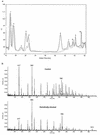Heat and osmotic stress responses of probiotic Lactobacillus rhamnosus HN001 (DR20) in relation to viability after drying
- PMID: 12571012
- PMCID: PMC143580
- DOI: 10.1128/AEM.69.2.917-925.2003
Heat and osmotic stress responses of probiotic Lactobacillus rhamnosus HN001 (DR20) in relation to viability after drying
Abstract
The viability of lactic acid bacteria in frozen, freeze-dried, and air-dried forms is of significant commercial interest to both the dairy and food industries. In this study we observed that when prestressed with either heat (50 degrees C) or salt (0.6 M NaCl), Lactobacillus rhamnosus HN001 (also known as DR20) showed significant (P < 0.05) improvement in viability compared with the nonstressed control culture after storage at 30 degrees C in the dried form. To investigate the mechanisms underlying this stress-related viability improvement in L. rhamnosus HN001, we analyzed protein synthesis in cultures subjected to different growth stages and stress conditions, using two-dimensional gel electrophoresis and N-terminal sequencing. Several proteins were up- or down-regulated after either heat or osmotic shock treatments. Eleven proteins were positively identified, including the classical heat shock proteins GroEL and DnaK and the glycolytic enzymes glyceraldehyde-3-phosphate dehydrogenase, lactate dehydrogenase, enolase, phosphoglycerate kinase, and triose phosphate isomerase, as well as tagatose 1,6-diphosphate aldolase of the tagatose pathway. The phosphocarrier protein HPr (histidine-containing proteins) was up-regulated in cultures after the log phase irrespective of the stress treatments used. The relative synthesis of an ABC transport-related protein was also up-regulated after shock treatments. Carbohydrate analysis of cytoplasmic contents showed higher levels (20 +/- 3 microg/mg of protein) in cell extracts (CFEs) derived from osmotically stressed cells than in the unstressed control (15 +/- 3 microg/mg of protein). Liquid chromatography of these crude carbohydrate extracts showed significantly different profiles. Electrospray mass spectrometry analysis of CFEs revealed, in addition to normal mono-, di-, tri-, and tetrasaccharides, the presence of saccharides modified with glycerol.
Figures








Similar articles
-
Heat shock response in Lactobacillus plantarum.Appl Environ Microbiol. 2004 Mar;70(3):1336-46. doi: 10.1128/AEM.70.3.1336-1346.2004. Appl Environ Microbiol. 2004. PMID: 15006751 Free PMC article.
-
Comparative survival of probiotic lactobacilli spray-dried in the presence of prebiotic substances.J Appl Microbiol. 2004;96(5):1024-39. doi: 10.1111/j.1365-2672.2004.02219.x. J Appl Microbiol. 2004. PMID: 15078519
-
Effect of water activity and protective solutes on growth and subsequent survival to air-drying of Lactobacillus and Bifidobacterium cultures.Appl Microbiol Biotechnol. 2012 Aug;95(3):745-56. doi: 10.1007/s00253-012-3912-8. Epub 2012 Feb 22. Appl Microbiol Biotechnol. 2012. PMID: 22350318
-
Two-dimensional electrophoresis study of Lactobacillus delbrueckii subsp. bulgaricus thermotolerance.Appl Environ Microbiol. 2002 Mar;68(3):1055-63. doi: 10.1128/AEM.68.3.1055-1063.2002. Appl Environ Microbiol. 2002. PMID: 11872450 Free PMC article.
-
Life under stress: the probiotic stress response and how it may be manipulated.Curr Pharm Des. 2008;14(14):1382-99. doi: 10.2174/138161208784480225. Curr Pharm Des. 2008. PMID: 18537661 Review.
Cited by
-
Anhydrobiosis in bacteria: from physiology to applications.J Biosci. 2011 Dec;36(5):939-50. doi: 10.1007/s12038-011-9107-0. J Biosci. 2011. PMID: 22116292 Review.
-
Polymorphisms, Chromosomal Rearrangements, and Mutator Phenotype Development during Experimental Evolution of Lactobacillus rhamnosus GG.Appl Environ Microbiol. 2016 Jun 13;82(13):3783-92. doi: 10.1128/AEM.00255-16. Print 2016 Jul 1. Appl Environ Microbiol. 2016. PMID: 27084020 Free PMC article.
-
Scalable temperature induced stress for the large-scale production of functionalized Bifidobacteria.J Ind Microbiol Biotechnol. 2015 Sep;42(9):1225-31. doi: 10.1007/s10295-015-1650-5. Epub 2015 Jul 11. J Ind Microbiol Biotechnol. 2015. PMID: 26162630
-
GroES/GroEL and DnaK/DnaJ have distinct roles in stress responses and during cell cycle progression in Caulobacter crescentus.J Bacteriol. 2006 Dec;188(23):8044-53. doi: 10.1128/JB.00824-06. Epub 2006 Sep 15. J Bacteriol. 2006. PMID: 16980445 Free PMC article.
-
How do bifidobacteria counteract environmental challenges? Mechanisms involved and physiological consequences.Genes Nutr. 2011 Aug;6(3):307-18. doi: 10.1007/s12263-010-0207-5. Epub 2011 Jan 13. Genes Nutr. 2011. PMID: 21484166 Free PMC article.
References
-
- Ang, D., K. Libereck, D. Skowyra, M. Zylicz, and C. Georgopoulos. 1991. Biological role and regulation of the universally conserved heat shock proteins. J. Biol. Chem. 266:24233-24236. - PubMed
-
- Branny, P., F. de la Torre, and J. R. Garel. 1998. An operon encoding three glycolytic enzymes in L. delbrueckii subsp. bulgaricus: glyceraldehyde-3-phosphate dehydrogenase, phosphoglycerate kinase and triosephosphate isomerase. Microbiology 144:905-914. - PubMed
-
- Brassart, D., and E. Schiffirin. 1997. The use of probiotics to reinforce mucosal defence mechanisms. Trends Food Sci. Technol. 8:321-326.
-
- Broadbent, J. R., C. J. Oberg, C. Wang, and L. Wei. 1997. Attributes of heat shock response in three species of dairy Lactobacillus. Sys. Appl. Microbiol. 20:12-19.
MeSH terms
Substances
LinkOut - more resources
Full Text Sources
Other Literature Sources
Research Materials

